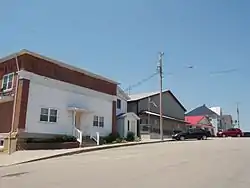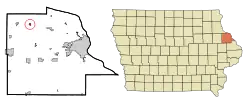Holy Cross, Iowa
Holy Cross is a city in Dubuque County, Iowa, United States. It is part of the Dubuque, Iowa Metropolitan Statistical Area. The population was 356 at the time of the 2020 census, down from 399 in 2000.[2]
Holy Cross, Iowa | |
|---|---|
 | |
 Location of Holy Cross, Iowa | |
| Coordinates: 42°36′1″N 90°59′40″W | |
| Country | |
| State | |
| County | Dubuque |
| Area | |
| • Total | 0.33 sq mi (0.85 km2) |
| • Land | 0.33 sq mi (0.85 km2) |
| • Water | 0.00 sq mi (0.00 km2) |
| Elevation | 1,211 ft (369 m) |
| Population (2020) | |
| • Total | 356 |
| • Density | 1,085.37/sq mi (419.31/km2) |
| Time zone | UTC-6 (Central (CST)) |
| • Summer (DST) | UTC-5 (CDT) |
| ZIP code | 52053 |
| Area code | 563 |
| FIPS code | 19-36885 |
| GNIS feature ID | 0457572 |
Geography
Holy Cross is located at 42°36′1″N 90°59′40″W (42.600334, -90.994557).[3]
According to the United States Census Bureau, the city has a total area of 0.34 square miles (0.88 km2), all land.[4]
The city is located approximately four miles east of Luxemburg and about 25 miles northwest of Dubuque.
History
Originally the community was settled by Irish and German immigrants in the early 19th century. The settlement became known as Pin Oak in 1844, the name originating from the many pin oak trees native to the area and after the rural post office located near there.
In 1855 the settlement's name changed again, to Georgetown. This name honored George Gallon, who offered to donate part of his land to build a town. In 1898 the name was once again changed to Holy Cross.
On May 17, 2004 several buildings in town were either damaged or destroyed when major storms ripped through the area. One notable casualty was the Holy Cross Catholic Church. The church suffered serious damage when part of its roof was ripped off in the storm. The interior of the church suffered water damage from the rain. Following the storm, a new roof was placed on the church building, and the interior was also repaired.
Demographics
| Year | Pop. | ±% |
|---|---|---|
| 1900 | 115 | — |
| 1910 | 143 | +24.3% |
| 1920 | 98 | −31.5% |
| 1930 | 111 | +13.3% |
| 1940 | 123 | +10.8% |
| 1950 | 139 | +13.0% |
| 1960 | 157 | +12.9% |
| 1970 | 290 | +84.7% |
| 1980 | 310 | +6.9% |
| 1990 | 293 | −5.5% |
| 2000 | 339 | +15.7% |
| 2010 | 374 | +10.3% |
| 2020 | 356 | −4.8% |
| Source:"U.S. Census website". United States Census Bureau. Retrieved March 29, 2020. and Iowa Data Center Source: | ||

2010 census
As of the census[6] of 2010, there were 374 people, 151 households, and 107 families residing in the city. The population density was 1,100.0 inhabitants per square mile (424.7/km2). There were 158 housing units at an average density of 464.7 per square mile (179.4/km2). The racial makeup of the city was 99.5% White and 0.5% from two or more races. Hispanic or Latino of any race were 1.1% of the population.
There were 151 households, of which 37.1% had children under the age of 18 living with them, 58.3% were married couples living together, 10.6% had a female householder with no husband present, 2.0% had a male householder with no wife present, and 29.1% were non-families. 25.8% of all households were made up of individuals, and 8.6% had someone living alone who was 65 years of age or older. The average household size was 2.48 and the average family size was 3.02.
The median age in the city was 35 years. 28.1% of residents were under the age of 18; 8.5% were between the ages of 18 and 24; 24.6% were from 25 to 44; 22.7% were from 45 to 64; and 16% were 65 years of age or older. The gender makeup of the city was 49.5% male and 50.5% female.
2000 census
As of the census[7] of 2000, there were 339 people, 132 households, and 97 families residing in the city. The population density was 1,191.8 inhabitants per square mile (460.2/km2). There were 139 housing units at an average density of 488.7 per square mile (188.7/km2). The racial makeup of the city was 100.00% White.

There were 132 households, out of which 36.4% had children under the age of 18 living with them, 64.4% were married couples living together, 8.3% had a female householder with no husband present, and 25.8% were non-families. 22.7% of all households were made up of individuals, and 9.1% had someone living alone who was 65 years of age or older. The average household size was 2.57 and the average family size was 3.06.
In the city, the population was spread out, with 28.6% under the age of 18, 6.5% from 18 to 24, 28.3% from 25 to 44, 18.0% from 45 to 64, and 18.6% who were 65 years of age or older. The median age was 37 years. For every 100 females, there were 111.9 males. For every 100 females age 18 and over, there were 103.4 males.
As of 2000 the median income for a household was $38,125, and the median income for a family was $41,136. Males had a median income of $30,694 versus $18,333 for females. The per capita income for the city was $16,629. About 6.8% of families and 8.7% of the population were below the poverty line, including 12.9% of those under age 18 and 17.8% of those age 65 or over.
Cemetery
The Holy Cross Catholic Cemetery is located just to the north of the Holy Cross Catholic Church. As of 2013, there were over 1700 buried in the cemetery.[8]
Education
Residents are within the Western Dubuque Community School District.[9] Zoned schools include Epworth Elementary School in Epworth,[10] Drexler Middle School in Farley, and Western Dubuque High School in Epworth.[11]
References
- "2020 U.S. Gazetteer Files". United States Census Bureau. Retrieved March 16, 2022.
- "2020 Census State Redistricting Data". census.gov. United states Census Bureau. Retrieved August 12, 2021.
- "US Gazetteer files: 2010, 2000, and 1990". United States Census Bureau. February 12, 2011. Retrieved April 23, 2011.
- "US Gazetteer files 2010". United States Census Bureau. Archived from the original on January 25, 2012. Retrieved May 11, 2012.
- "Census of Population and Housing". Census.gov. Retrieved June 4, 2015.
- "U.S. Census website". United States Census Bureau. Retrieved May 11, 2012.
- "U.S. Census website". United States Census Bureau. Retrieved January 31, 2008.
- "Holy Cross Catholic Cemetery - Dubuque County, Iowa". Iowa Gravestone Photo Project. Retrieved February 22, 2013.
- "Western Dubuque." Iowa Department of Education. Retrieved on July 24, 2018.
- "2017 Elementary Boundaries." Western Dubuque Community School District. Retrieved on July 24, 2018. Detail on Balltown, Holy Cross, and Rickardsville
- "WDHS Boundary map." Western Dubuque Community School District. Retrieved on July 24, 2018.